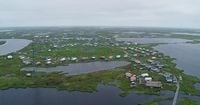The aftermath of Typhoon Halong’s remnants has left a trail of devastation across western Alaska, with entire communities uprooted and hundreds of residents forced to start anew. The storm, which struck over the weekend of October 11-12, 2025, brought record rainfall and a deadly storm surge that battered the Yukon-Kuskokwim Delta, impacting more than 40 remote villages including Kipnuk and Kwigillingok. These villages, perched near the Bering Sea and home to predominantly Alaska Native populations, faced water levels more than six feet above the highest normal tide line, according to reports from the Alaska Division of Homeland Security and Emergency Management cited by FOX Weather and other outlets.
For many, the crisis unfolded with terrifying speed. Alexie Stone, a resident of Kipnuk, recalled, "The house rocked as though an earthquake had struck, and suddenly it was floating." Stone and his family, like so many others, found themselves clinging to safety in the lone dry room of their home as waves battered the windows. Eventually, the house drifted and settled several feet from its foundation, rendered uninhabitable by the floodwaters. Stone and his family spent several nights on the floor of the Kipnuk school library before being airlifted first to Bethel and then, along with hundreds of others, to Anchorage aboard a military transport plane.
The human toll of the disaster is sobering. At least one person, Ella Mae Kashatok, 67, died in Kwigillingok, and two men—Chester Kashatok, 41, and Vernon Pavil, 71—remain missing after their home was swept away. The U.S. Coast Guard mounted dramatic rescues, including saving two dozen people from floating homes in Kwigillingok. As the storm receded, the scale of the destruction became clear: 121 homes were destroyed in Kipnuk alone, and 36 homes in Kwigillingok were swept away, according to state officials and The Independent.
Evacuation efforts have been described as unprecedented in Alaska’s history. More than 1,000 residents were airlifted to safety, with approximately 300 evacuees arriving at Joint Base Elmendorf-Richardson near Anchorage on October 15, 2025. The Alaska Division of Homeland Security and the American Red Cross worked quickly to convert the Alaska Airlines Sports Center into an emergency shelter, setting up 300 cots within hours. Harry Snyder, who was evacuated from Kwigillingok with his wife, three children, parents, and a dozen other family members, described the ordeal: “My dad said, wake up—there’s water! There’s water under the house! And as soon as I looked out the window man, it was water, it was water, all over.”
For Snyder, the hardest part was facing his children’s questions about when they could go home. “Man, it was hard for me to say but I had to say something about it. I told them babies, ‘I’m sorry, the house is gone, it’s not where it was,’ it’s hard.” The family, like many others, is now relying on the basics provided at the shelter—food, clothing, and a place to sleep. “We are going to start off from scratch, we are going to start a new chapter,” Snyder said, expressing hope for a fresh start in Anchorage.
As the airlift continued, the logistical challenges mounted. The flooding severely damaged regional airports, complicating access to the already isolated villages, which lack a continuous road system and are reachable only by air or water at this time of year. The Coastal Villages Region Fund (CVRF) stepped in to provide generators, repair kits, and replacement parts for vital equipment like snowmobiles, ATVs, and boats. “Typhoon Halong has devastated our region and disrupted the lives of all our residents. People have lost loved ones, homes, belongings, in some cases their entire community and their way of life. The evacuation underway is unprecedented in western Alaska—the military and first responders deserve our eternal gratitude,” said Eric Deakin, CEO of CVRF, in a statement to FOX Weather.
Relief efforts have been robust but the needs remain acute. The Alaska National Guard flew more than 21,000 pounds of supplies into the region on October 14-15, 2025, and Chinook helicopters delivered water and other essentials to Kipnuk. The U.S. Coast Guard played a critical role in rescuing residents stranded by floodwaters. The Red Cross, which deployed volunteers from across the country, provided cots, blankets, hygiene supplies, and coordinated the distribution of donated goods. By October 16, 2025, the Red Cross announced it had received enough donated items for the Sports Center shelter, asking the public to pause further donations for the time being.
The storm’s impact is not only immediate but threatens the traditional subsistence lifestyle of many in these communities. The Red Cross warned that the flooding could jeopardize food stores meant to last through the harsh Alaskan winter. Stone, for example, lost three freezers full of halibut, salmon, moose, and goose—food that would have sustained his family for months. Fuel and stove oil leaks have created hazardous conditions, and the lingering odor of petroleum adds to the sense of loss and disruption.
Officials are racing against time to move evacuees from congregate shelters into hotel rooms or dormitories, a daunting task given the scale of the disaster and the region’s remoteness. The Bethel shelter, which served as a hub for initial evacuations, was already facing depleted food supplies by midweek, according to FEMA. The Yukon Kuskokwim Health Corp. warned that the armory shelter might have to close, further straining resources as winter approaches and temperatures plunge into the 20s Fahrenheit.
Damage assessments are ongoing, but experts agree that recovery will be a monumental challenge. Most construction materials must be flown or shipped in, and the window for repairs is rapidly closing as winter sets in. Many homes are beyond repair and deemed unsafe, even with emergency fixes. Water, sewer, and well systems remain inoperable in some villages, and the restoration of basic services is a top priority.
Despite the hardship, the resilience of the affected communities shines through. “In our village, we’d say that we’re Native strong, we have Native pride, and nothing can break us down. But this is the hardest that we went through,” Stone said outside the Anchorage shelter. His mother, Julia Stone, a village police officer, echoed the sentiment: “It’s a nightmare what we went through, but I thank God we are together.”
The coming weeks will test that resilience as families like the Snyders and Stones face the daunting task of rebuilding their lives from scratch. But as the first snows threaten and the days grow shorter, one thing is clear: the spirit of these Alaska Native communities endures, even in the face of unprecedented loss.






